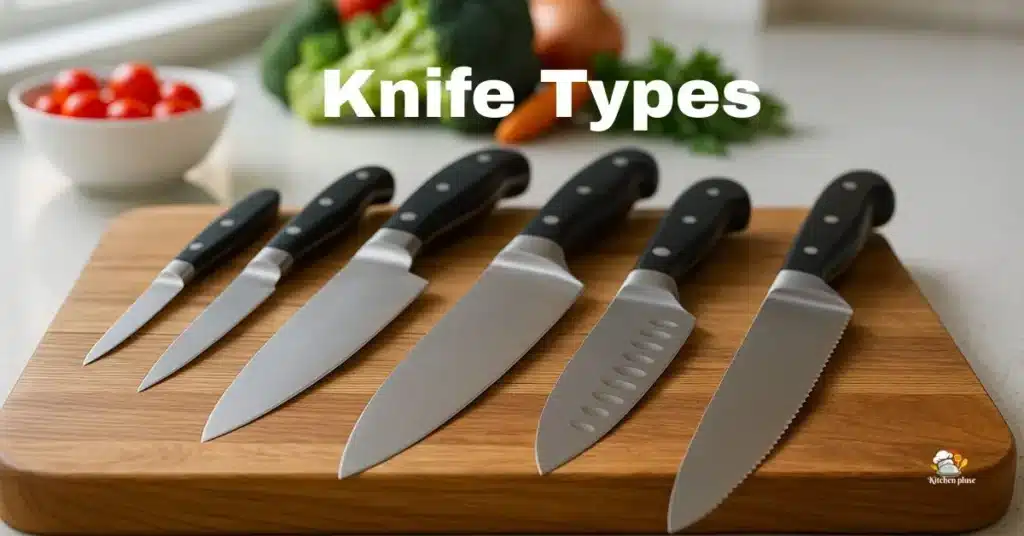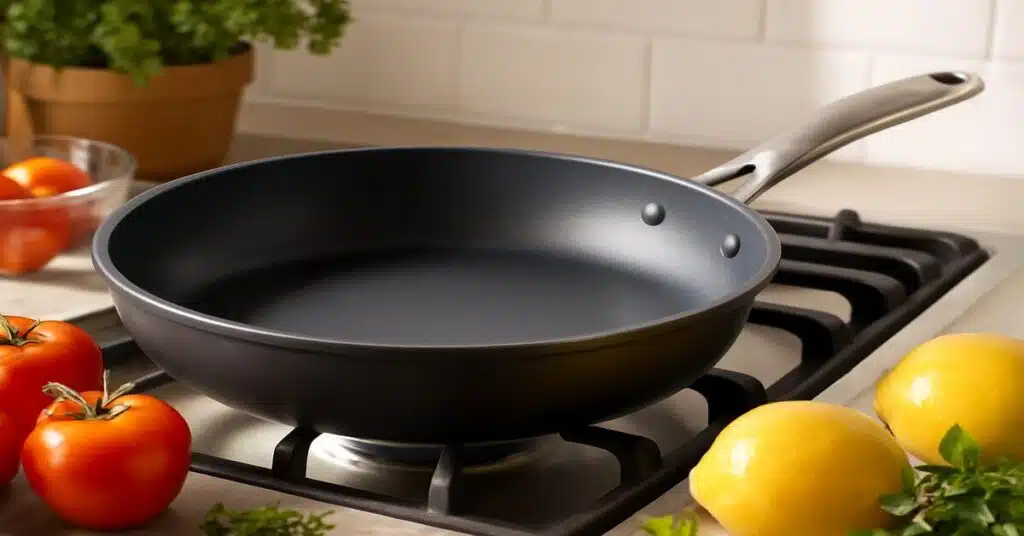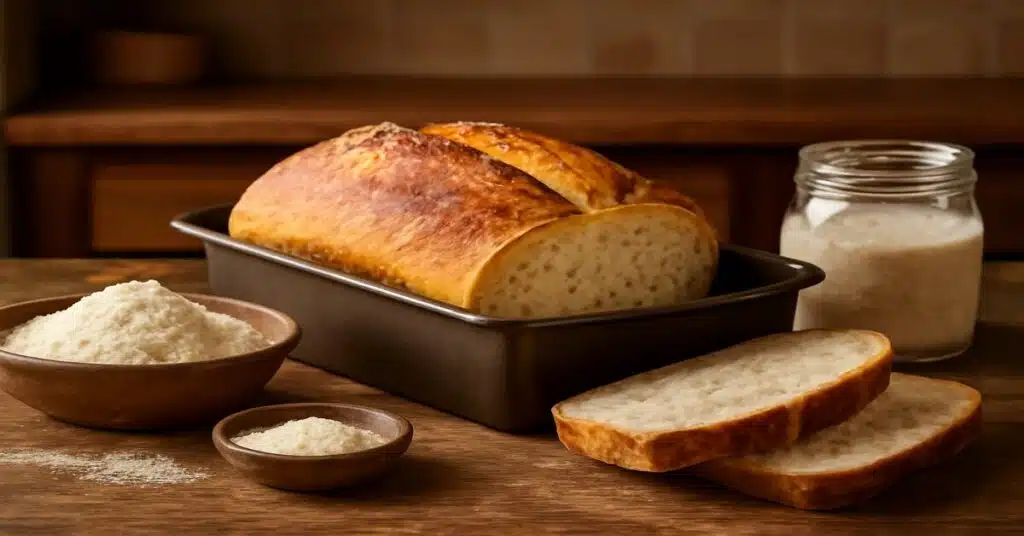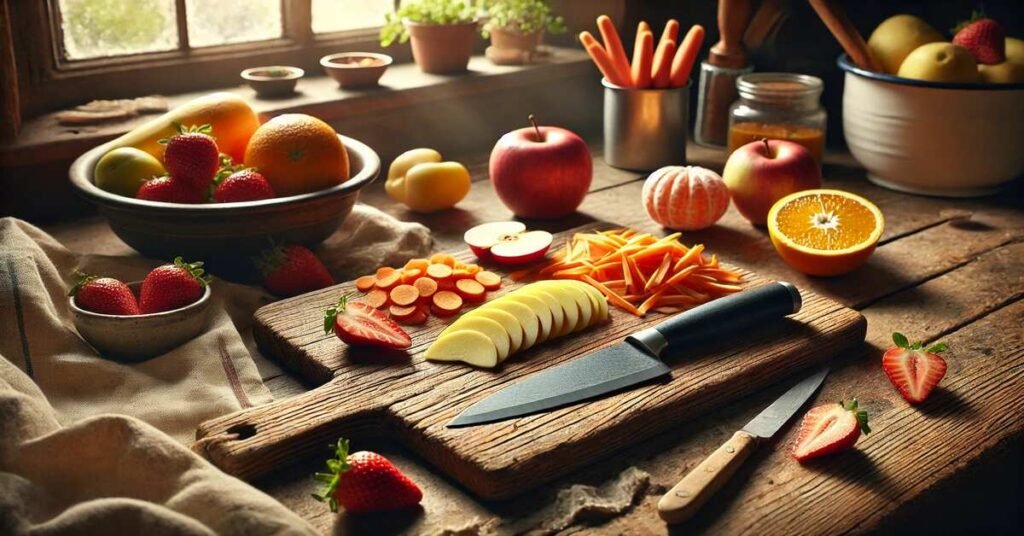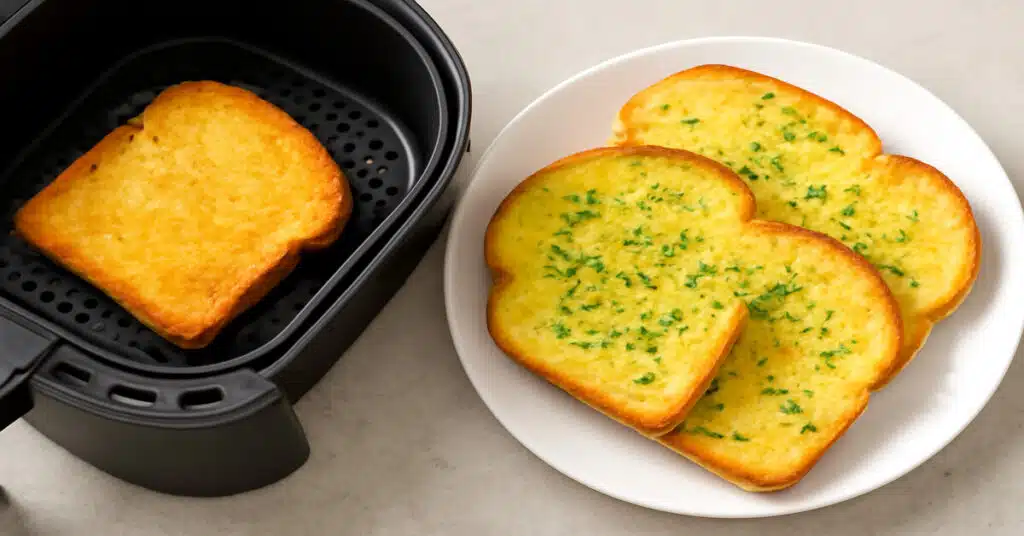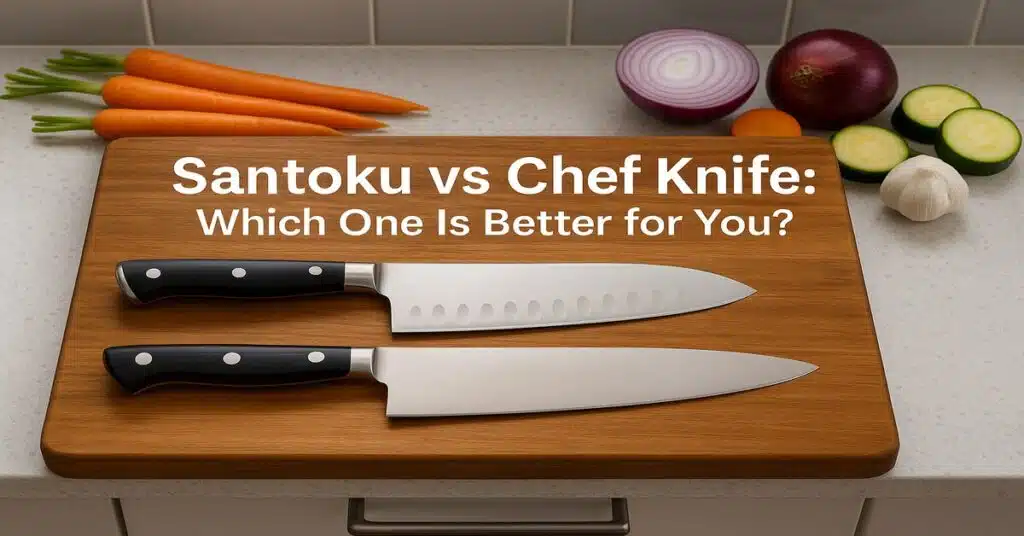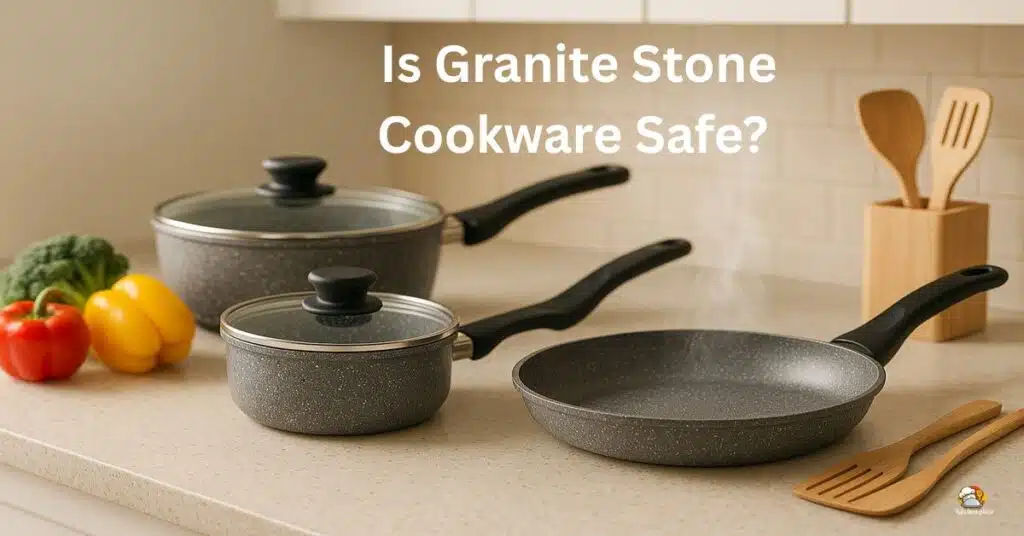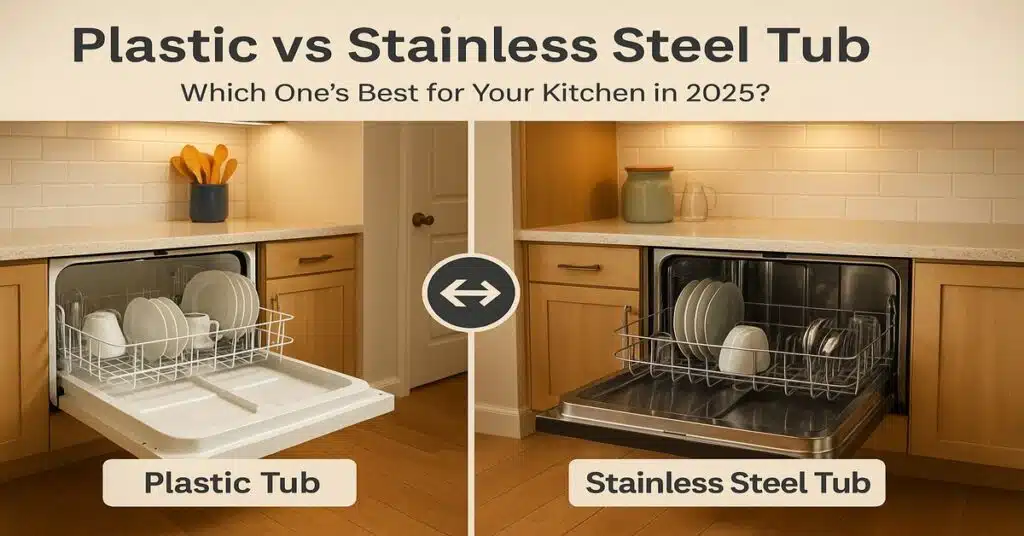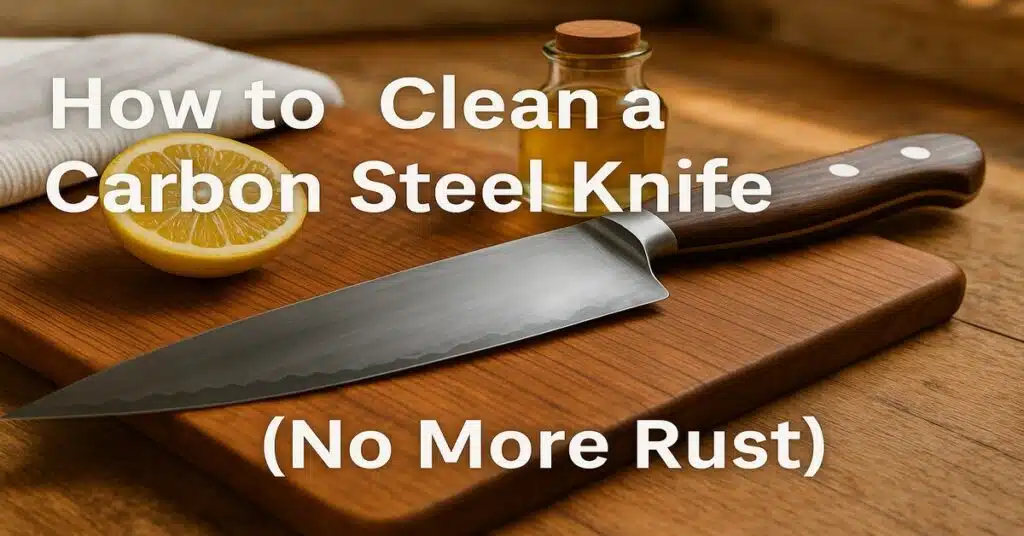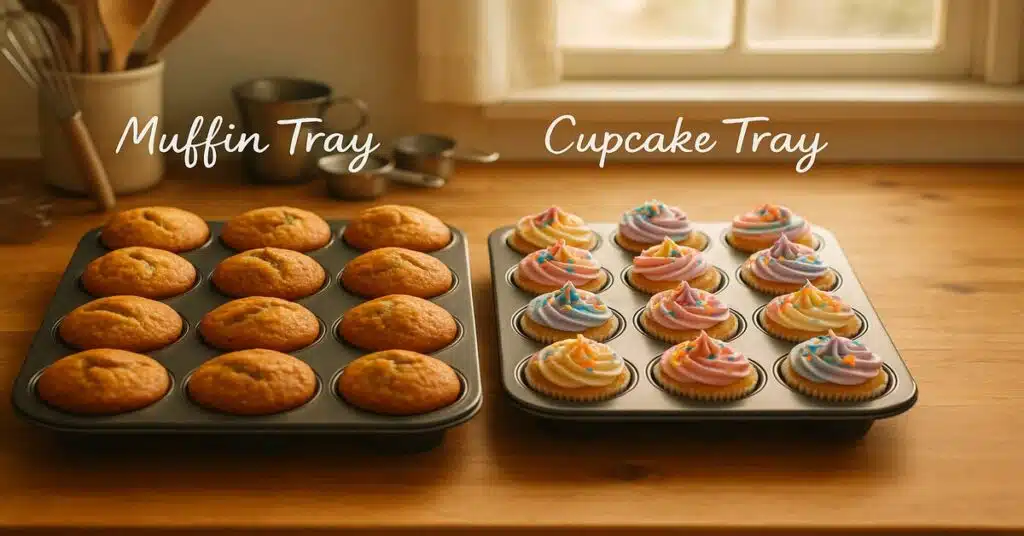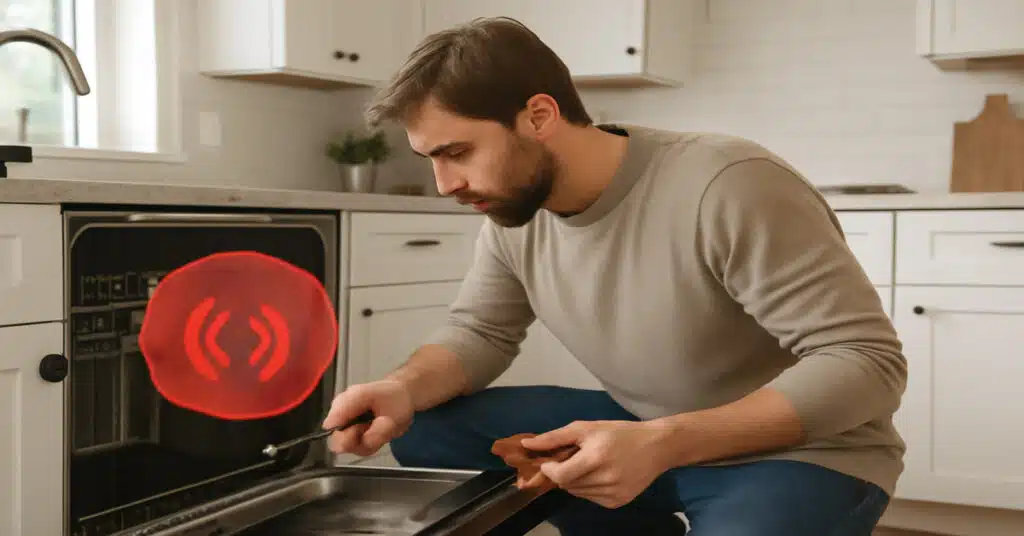Knowing which knife to use makes cooking safer, faster, and more enjoyable.
In this 2025 kitchen-knife guide, you’ll discover the main types of kitchen knives — such as the Chef’s Knife, Santoku, Paring, Bread, and Boning Knives — and learn how each one helps you cook with precision and ease.
Every knife in this guide was tested and reviewed by MD Soazim, Kitchen Product Analyst at KitchenPluse.com.All testing took place in real U.S. kitchens to make sure results match everyday cooking.
Whether you’re a beginner learning knife basics or a professional chef improving your setup, this article will help you choose the right blade for every task.
Trusted brands such as Wüsthof, Shun, and Victorinox are featured for their balance, sharpness, and design — giving you clear, expert-tested insights for 2025.
See our expert-tested list of the best kitchen knives — updated for 2025 with top picks from Wüsthof, Shun, and Victorinox.
Now that you know what this guide covers, let’s start by exploring the main types of kitchen knives.
What Are the Main Types of Kitchen Knives?
There are six main types of kitchen knives every cook should know:
- Chef’s Knife – the all-purpose knife for most kitchen tasks.
- Santoku Knife – a Japanese knife designed for smooth, precise slicing.
- Paring Knife – perfect for peeling, trimming, and cutting small fruits and vegetables.
- Utility Knife – a mid-sized knife used for daily prep and quick cutting.
- Bread Knife – features a serrated edge that slices through crusty loaves without squashing them.
- Boning Knife – a thin, flexible blade for trimming fat and separating meat from bone.
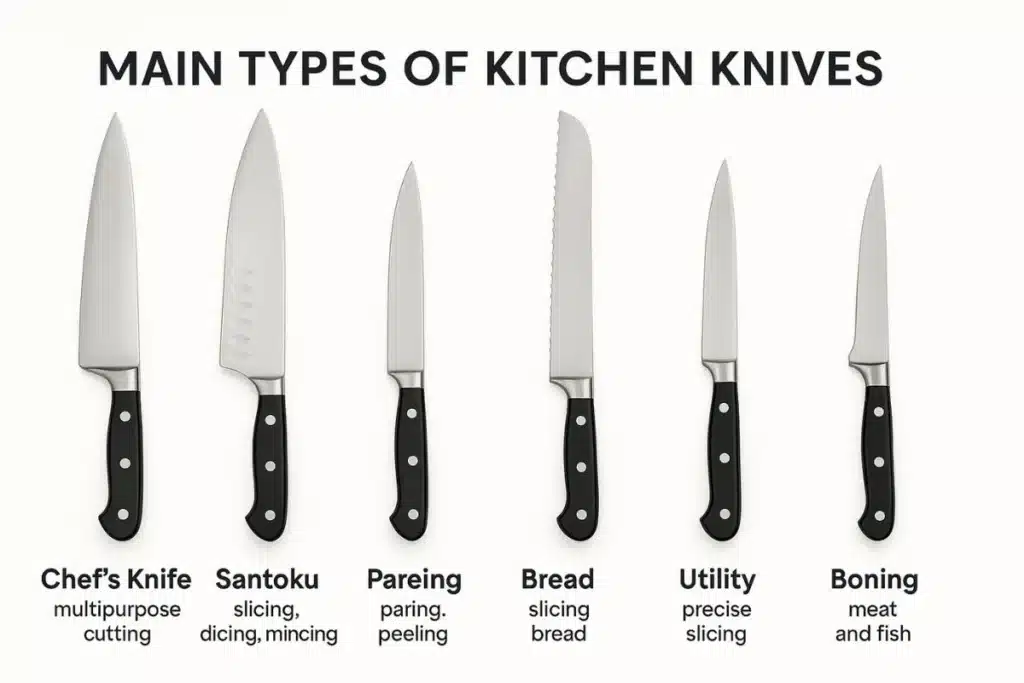
These six knives are the essential tools for cooking, forming the foundation of every well-equipped kitchen.
They are used daily by both home cooks and professional chefs across the U.S.
Each blade has its own role — from chopping vegetables to carving meat — and knowing when to use the right knife helps you cook faster, safer, and with more control.
Now that we’ve listed the main knife types, let’s dive into each one and see what makes them special.
Chef’s Knife — The All-Rounder
Length: 8–10 inches | Best for: vegetables, meat, herbs
The chef’s knife, also known as a cook’s knife, is the most important and versatile tool in any kitchen.
It’s used for almost every cooking task — from chopping vegetables to slicing meat — which is why it’s often called the all-purpose knife.
Made from German X50CrMoV15 forged steel, it offers excellent balance, durability, and long-lasting sharpness.
The curved blade helps you rock smoothly while cutting, making it comfortable and safe for both beginners and professionals.
Top Brands: Wüsthof Classic and Zwilling Pro — both trusted German-made chef’s knives known for their strength and precision.
Once you’ve mastered the chef’s knife, you’ll want to discover how the Japanese Santoku brings even more precision.
Santoku Knife — Japanese Precision
Origin: Japan | Steel: VG-MAX Damascus
The Santoku knife is a Japanese all-purpose kitchen knife made for precision and balance.It’s mainly used for thin, controlled slicing — ideal for cutting vegetables, sushi, and other delicate foods.
Unlike a chef’s knife, which has a curved edge for rocking cuts, the Santoku features a straight edge that allows smooth push-cuts for cleaner slices.
Forged from VG-MAX Damascus steel, it combines razor-sharp edges with beautiful layered patterns that show true Japanese craftsmanship.
Top Brand Example: Shun Classic Santoku — known for its lightweight design, sharp edge, and elegant Damascus finish.
Moving from Japanese precision to small-scale control, let’s look at the paring knife.
Paring Knife — For Fine Work
Length: 3–4 inches | Best for: peeling, trimming, and small detail cuts
The paring knife is a small, lightweight kitchen knife made for precision work.
It’s mainly used for peeling fruits, trimming fat, and removing seeds—tasks that need accuracy and control.
Because of its short blade and pointed tip, the paring knife helps you handle delicate ingredients like garlic, strawberries, or shrimp with confidence.
Most models, such as the Victorinox Paring Knife, feature a stainless steel blade that stays sharp, rust-free, and easy to clean even after daily use.
Pro Tip: Use a paring knife when your chef’s knife feels too large for detailed cutting tasks.
Learn more about its everyday uses and types → What Is a Paring Knife Used For
From tiny cuts to crusty loaves, let’s explore the bread knife next.
Bread Knife — Serrated Strength
Length: 10 inches | Best for: bread, cakes, and pastries
The bread knife has a long serrated edge that cuts through crusty loaves without crushing the soft inside. It’s a must-have for bakers and home cooks who love sourdough, pastries, or cakes.
The saw-like teeth make it easy to slice thick crusts while keeping crumbs minimal and cuts clean.
A quality model — like the Wüsthof Classic Bread Knife — offers a sharp scalloped edge and a balanced handle for smooth, controlled slicing.
Pro Tip: Don’t use your bread knife on bones or frozen foods; it’s built for slicing, not chopping.
Now that we’ve sliced through bread and pastries, it’s time to talk about meat precision — the boning knife.
Boning Knife — Precision for Meat
Length: 5–6 inches | Best for: trimming, filleting, and deboning
The boning knife is a narrow, flexible blade made to separate meat from bone with precision and minimal waste.
It’s a must-have tool for meat and seafood preparation, allowing you to trim fat, remove skin, and cut cleanly around bones in chicken, beef, or fish.
Because the blade can bend slightly, it follows the natural curves of the meat, giving more control than heavier knives.
A reliable option like the Victorinox Fibrox Pro Boning Knife features a 6-inch stainless-steel blade and a non-slip ergonomic handle, designed for comfort and safety during long prep sessions.
Pro Tip: Use a stiff boning knife for dense meats like beef and pork, and a flexible one for delicate cuts such as poultry and fish.
Learn more in our full guide What Is a Boning Knife Used For including when to use stiff vs flexible blades.
Great! Now that we’ve covered all key knives, let’s compare them side by side.
How Do Different Kitchen Knife Types Compare in 2025?
If you’ve ever wondered which kitchen knife is best for your cooking style, here’s the quick answer:
Chef’s, Santoku, Paring, Bread, and Boning knives all serve different purposes depending on blade size, steel type, and cutting style.
This comparison table explains how they differ so you can choose the perfect knife for your needs.
| Knife Type | Typical Size | Best For | Steel / Material | Maintenance | Skill Level |
| Chef’s Knife | 8–10 inches | All-purpose cutting — vegetables, meat, herbs | Forged German X50CrMoV15 | Low | Easy |
| Santoku Knife | 6–7 inches | Thin, precise slicing | VG-MAX Damascus (Japanese) | Medium | Moderate |
| Paring Knife | 3–4 inches | Peeling and fine trimming | Stainless Steel | Low | Easy |
| Bread Knife | 10 inches | Bread, pastries, and cakes | High-Carbon Steel | Low | Easy |
| Boning Knife | 5–6 inches | Meat and fish — trimming and deboning | Flexible Stainless Steel | Medium | Moderate |
With these details clear, the next question is — which knife should you choose for each cooking task?
How to Choose the Right Knife for Each Task
Every cooking task needs the right knife for the job.The trick is to match the blade type with what you’re cutting — vegetables, meat, or bread — and to choose based on balance, comfort, and steel quality.
Here’s a quick guide showing which knife works best for each kitchen task:
| Task | Best Knife Type | Why It Works Best | Extra Tip |
| Vegetables | Santoku or Nakiri Knife | The flat edge makes smooth, even cuts — ideal for slicing and dicing. | Pick a lighter knife with a thin spine for precise control. |
| Meat | Chef’s Knife or Boning Knife | A sharp edge handles thick cuts; the boning knife trims fat and separates bones easily. | Forged steel gives better balance and strength. |
| Bread & Pastries | Serrated Bread Knife | Saw-like teeth glide through crusts without crushing soft bread. | Slice gently instead of chopping to avoid crumbs. |
Pro Tip: Always hold the knife and check the balance before buying — a well-balanced handle makes cutting safer and easier.
Want to Find Your Perfect Kitchen Knife?
Compare top-rated knives by brand, steel, and comfort in our Best Kitchen Knives 2025 Buying Guide.
Once you’ve matched each knife to its job, it’s time to understand how knife construction affects performance.
Forged vs Stamped Knives — What’s the Difference?
Have you ever noticed that some knives feel heavier and more solid, while others are light and flexible?
That difference comes from how the knife is made — whether it’s forged or stamped.
| Type | How It’s Made | Main Qualities | Best For | Maintenance |
| Forged Knife | Made by heating and hammering a single piece of steel. | Heavier, stronger, and more balanced; keeps its edge longer. | Professional chefs and serious home cooks. | Low — needs only light honing. |
| Stamped Knife | Cut directly from a flat steel sheet with a machine press. | Lightweight, flexible, and more affordable. | Everyday home use and quick prep work. | Medium — needs regular sharpening. |
In short:
- Forged knives are durable, well-balanced, and built to last.
- Stamped knives are lighter, easier to handle, and budget-friendly.
Now that you know how knives are built, let’s see how style and culture shape Japanese and Western knives differently.
🇯🇵 Japanese vs Western Knives — What’s the Difference? (Power vs Precision)
Ever wondered what makes Japanese and Western kitchen knives different?
The main differences come from edge design, steel hardness, weight balance, and cutting technique — or simply put, precision vs power.
| Feature | Japanese Knives | Western Knives |
| Edge Angle | 15° per side — sharper for clean, thin slices. | 20° per side — thicker edge for durability and easier maintenance. |
| Steel Hardness (HRC) | 60–63 — harder steel that keeps its edge longer. | 56–58 — softer steel that’s easier to sharpen. |
| Weight & Balance | Light and forward-balanced for precision. | Heavier and rear-balanced for power and control. |
| Cutting Style | Push-cut motion — perfect for clean slicing. | Rocking motion — best for heavy chopping. |
| Example Brands | Shun, Miyabi, Global (Japan). | Wüsthof, Zwilling, Victorinox (Germany). |
In short:
- Japanese knives focus on precision and artistry — ideal for detailed slicing and presentation.
- Western knives focus on power and durability — perfect for tough, everyday kitchen tasks.
Whichever side you prefer, one thing’s universal — safety and maintenance come first.
Knife Safety and Maintenance Tips (2025 Guide)
A sharp knife is safer than a dull one — but only when handled correctly.
Follow these simple do’s and don’ts to keep your kitchen safe and your knives in perfect condition.
✅ Do’s — Safe Knife Practices
- Keep knives sharp to avoid slipping and uneven cuts.
- Use a stable cutting board — avoid glass or metal surfaces.
- Store knives properly in a wooden block or magnetic strip.
- Use the claw grip to keep fingers safe while chopping.
- Wash and dry knives right after use to prevent rust or stains.
❌ Don’ts — Common Safety Mistakes
- Don’t leave knives in the sink or submerged in water.
- Don’t put knives in the dishwasher — heat and detergent dull the edge.
- Don’t use knives to pry open jars or cans.
- Don’t stack knives without guards — always protect the blades.
Maintenance Quick Tips
- Hone your knife weekly to realign the edge.
- Sharpen when needed using a whetstone or honing rod.
- Oil wooden handles every few months to prevent drying or cracking.
- Inspect regularly for chips, rust, or loose handles.
Pro Tip: A safe knife starts with good control. When chopping, keep your fingers curled under and your thumb behind the food — this “claw grip” helps you cut confidently and avoid slips.
Safety comes with care, and care means keeping your blades sharp — let’s learn how to maintain sharpness.
How to Maintain Sharpness (Sharpening Basics)
Keeping your knives sharp isn’t just about performance — it’s also about safety, precision, and longer blade life.
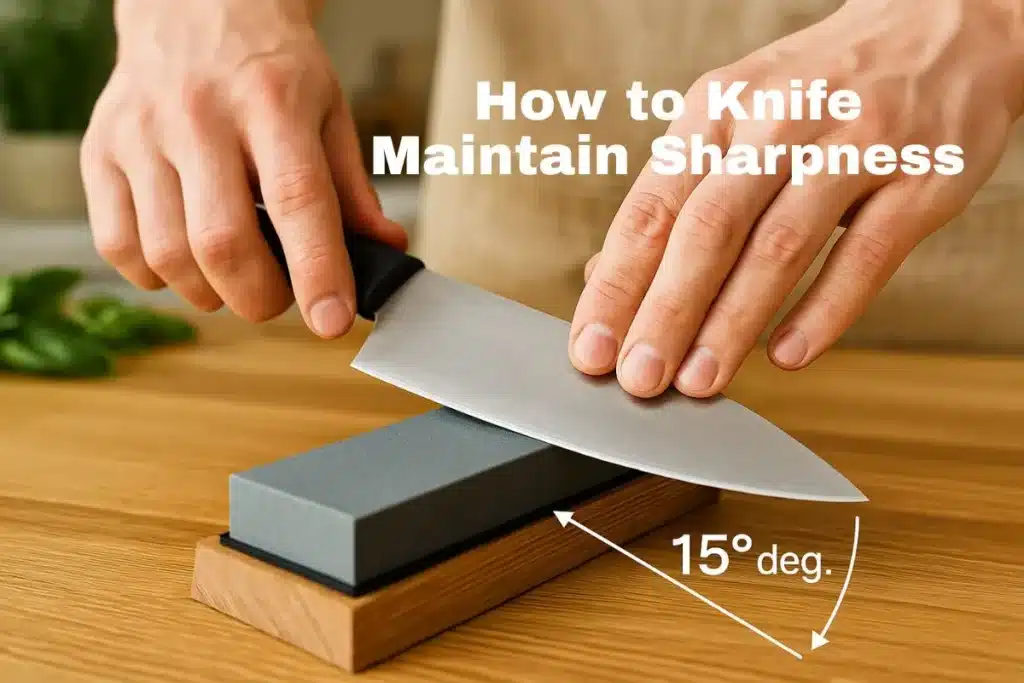
Here’s a quick, step-by-step guide showing how to keep your kitchen knives razor-sharp like a pro.
| Tool | Purpose | Recommended Use | Pro Tip |
| Whetstone (1000/6000 grit) | Restores dull edges | Use every 2–3 months for deep sharpening. | Keep a 15° angle for Japanese knives and 20° for Western knives. |
| Honing Rod (Steel or Ceramic) | Realigns blade edge | Use weekly to maintain straightness. | Apply light pressure and glide from heel to tip. |
| Electric Sharpener | Quick sharpening | Use occasionally for convenience. | Pick one with adjustable angles to match your knife type. |
Step-by-Step Sharpening Method
- Soak your whetstone in water for 10–15 minutes before use.
- Hold the knife at the correct angle and slide it smoothly across the stone.
- Sharpen both sides evenly, then hone lightly to finish and polish the edge.
Now that your knives are razor-sharp, let’s make sure you’re not making mistakes that could ruin them.
What Mistakes Should You Avoid When Using Kitchen Knives?
Even the best kitchen knives can lose their edge or get damaged if used the wrong way.
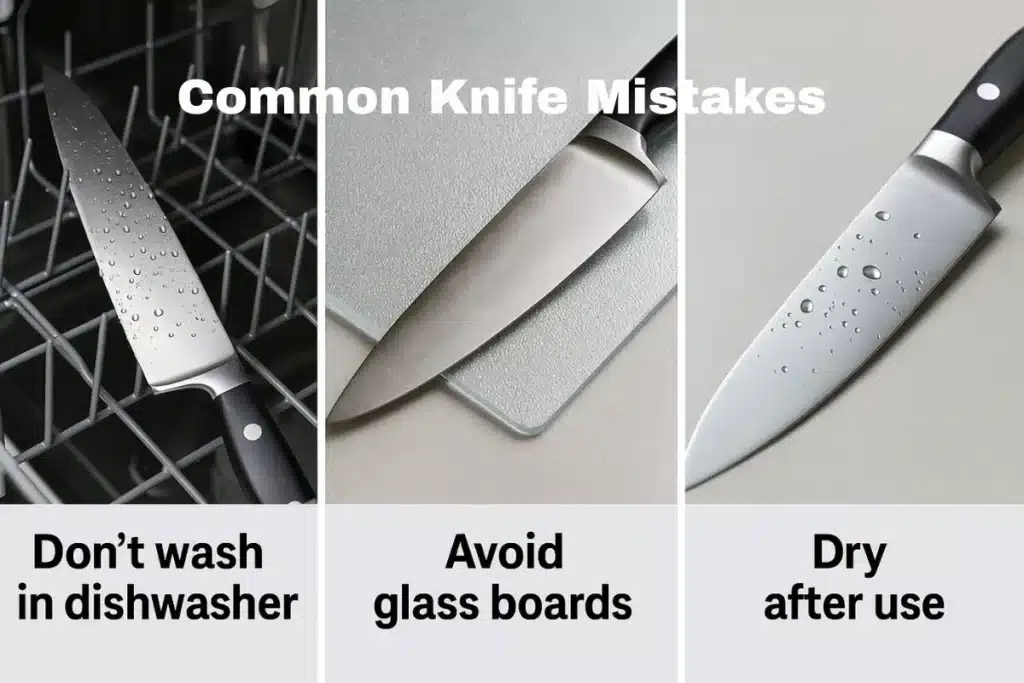
Here are the most common knife mistakes and how to avoid them so your blades stay sharp, safe, and long-lasting.
⚠️ Common Knife Mistakes
- Using glass or marble cutting boards — these hard surfaces quickly dull and chip the blade.
- Leaving knives wet after washing — moisture causes rust and weakens the steel over time.
- Storing knives loosely in drawers — blades bump together, losing sharpness and balance.
- Putting knives in the dishwasher — heat and detergent damage both the blade and handle.
- Cutting frozen food or bones — heavy resistance can bend or crack thinner blades.
Pro Tip: Always use a wooden or plastic cutting board, dry your knives right after cleaning, and store them safely on a magnetic strip or in a knife block.
With those mistakes out of the way, let’s look at some of the best knife sets available in 2025.
What Are the Best Kitchen Knife Sets of 2025?
If you’re upgrading your kitchen or want a complete knife bundle, these top-rated knife sets offer the perfect mix of quality, balance, and durability.
Each set below was tested for sharpness, comfort, and long-term use under real U.S. kitchen conditions.
| Brand & Model | Type | Best For | Why We Recommend It | Buy Now |
| Wüsthof Classic 7-Piece Set | Forged German Steel | Professional chefs | Excellent balance, full-tang forged build, and lifetime edge durability. | View on Amazon US |
| Shun Premier 5-Piece Set | Japanese Damascus Steel | Precision cooking | Razor-sharp VG-MAX blades with handcrafted Japanese design and elegant finish. | View on Amazon US |
| Cuisinart Triple Rivet 15-Piece Set | Stainless Steel Starter Kit | Everyday home use | Affordable and dishwasher-safe — ideal for beginners learning proper knife care. | View on Amazon US |
Pro Tip:
- Professionals often choose forged German sets (like Wüsthof) for their strength and control.
- Home cooks love Japanese Damascus knives (like Shun) for precision and visual appeal.
- If you’re a beginner, the Cuisinart 15-Piece Set covers every essential task at an unbeatable value.
Now that you’ve seen the top-rated sets, let’s wrap things up with final advice on choosing the perfect knife for you.
Final Thoughts — How to Choose the Right Kitchen Knife for You
A great knife isn’t just another kitchen tool — it’s a long-term investment in your cooking journey.
The best knife for you depends on what you cook most often and how comfortable it feels in your hand.
- For beginners: Start with a balanced Wüsthof Classic 8-inch Chef’s Knife — reliable, strong, and easy to control.
- For precision lovers: Add a Shun Classic Santoku — perfect for thin, clean slices and fine Japanese craftsmanship.
- For everyday prep: Keep a Victorinox Fibrox Pro Paring Knife — ideal for peeling, trimming, and small detail work.
By combining these three essential knives, you can handle almost any kitchen task — from chopping vegetables to carving meat.
Comfort, balance, and safety matter more than price or looks. The right knife is the one that fits naturally in your hand and makes cooking feel effortless.
Ready to upgrade your set?
Explore our full list of expert-tested picks in the Complete Kitchen Knife Buying Guide.
Still have questions? Don’t worry — our FAQs below cover everything you need to know before buying or using a knife.
FAQs — Types of Kitchen Knives and Their Uses (2025 Guide)
What are the main types of kitchen knives?
The main kitchen knives are chef’s, santoku, paring, bread, utility, and boning knives — each made for different cutting, slicing, and trimming tasks.
What are the 4 basic types of knives and their uses?
Chef’s knife for chopping, paring for peeling, bread knife for slicing loaves, and boning knife for removing meat from bones.
What is a Santoku Knife used for?
A Santoku knife is used for thin, precise slicing of vegetables, fish, and meat. It’s a Japanese-style knife made for cleaning, even cuts.
What is a Bread Knife used for?
A bread knife has a serrated edge that cuts crusty bread without crushing it — ideal for loaves, pastries, and soft cakes.
What is a Boning Knife used for?
A boning knife separates meat from bones and trims fat. Its narrow, flexible blade helps make clean, accurate cuts.
Learn more in our complete guide → What Is a Boning Knife Used For — perfect for trimming meat, removing fat, and achieving clean cuts like a pro.
What knife is best for cutting vegetables?
The best knives for vegetables are the Santoku and Nakiri knives — both give clean, even slices without damaging texture.
What knife is best for cutting meat?
For meat, use a Chef’s knife for large cuts and a Boning knife for precise trimming and deboning.
What is a Utility Knife used for?
A Utility Knife is a mid-sized knife used for everyday kitchen tasks — cutting sandwiches, fruits, and small vegetables.It’s great when a chef’s knife feels too big.
What’s the difference between Japanese and Western knives?
Japanese knives are sharper, thinner, and made for precision slicing.
Western knives are thicker and heavier, better for durability and tougher ingredients.
How many knives does a home cook really need?
Most home cooks only need three: a Chef’s Knife, a Paring Knife, and a Bread Knife. These handle nearly every kitchen task from chopping to slicing.
That’s a wrap! You now have everything you need to choose, use, and care for your kitchen knives like a pro.

